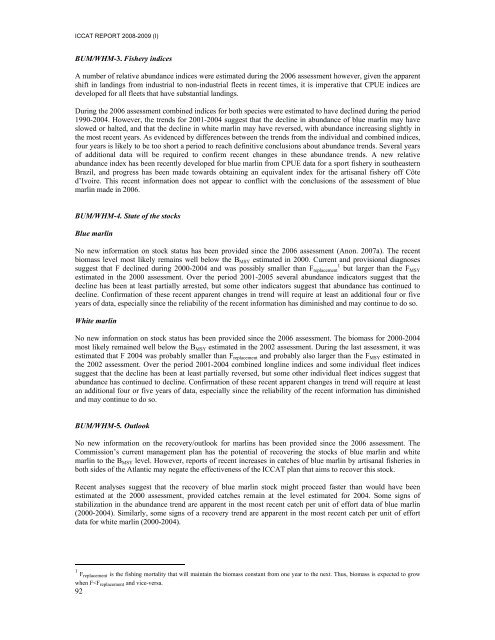REPORT OF THE STANDING COMMITTEE ON RESEARCH ... - Iccat
REPORT OF THE STANDING COMMITTEE ON RESEARCH ... - Iccat
REPORT OF THE STANDING COMMITTEE ON RESEARCH ... - Iccat
You also want an ePaper? Increase the reach of your titles
YUMPU automatically turns print PDFs into web optimized ePapers that Google loves.
ICCAT <strong>REPORT</strong> 2008-2009 (I)BUM/WHM-3. Fishery indicesA number of relative abundance indices were estimated during the 2006 assessment however, given the apparentshift in landings from industrial to non-industrial fleets in recent times, it is imperative that CPUE indices aredeveloped for all fleets that have substantial landings.During the 2006 assessment combined indices for both species were estimated to have declined during the period1990-2004. However, the trends for 2001-2004 suggest that the decline in abundance of blue marlin may haveslowed or halted, and that the decline in white marlin may have reversed, with abundance increasing slightly inthe most recent years. As evidenced by differences between the trends from the individual and combined indices,four years is likely to be too short a period to reach definitive conclusions about abundance trends. Several yearsof additional data will be required to confirm recent changes in these abundance trends. A new relativeabundance index has been recently developed for blue marlin from CPUE data for a sport fishery in southeasternBrazil, and progress has been made towards obtaining an equivalent index for the artisanal fishery off Côted’Ivoire. This recent information does not appear to conflict with the conclusions of the assessment of bluemarlin made in 2006.BUM/WHM-4. State of the stocksBlue marlinNo new information on stock status has been provided since the 2006 assessment (Anon. 2007a). The recentbiomass level most likely remains well below the B MSY estimated in 2000. Current and provisional diagnosessuggest that F declined during 2000-2004 and was possibly smaller than F replacement 1 but larger than the F MSYestimated in the 2000 assessment. Over the period 2001-2005 several abundance indicators suggest that thedecline has been at least partially arrested, but some other indicators suggest that abundance has continued todecline. Confirmation of these recent apparent changes in trend will require at least an additional four or fiveyears of data, especially since the reliability of the recent information has diminished and may continue to do so.White marlinNo new information on stock status has been provided since the 2006 assessment. The biomass for 2000-2004most likely remained well below the B MSY estimated in the 2002 assessment. During the last assessment, it wasestimated that F 2004 was probably smaller than F replacement and probably also larger than the F MSY estimated inthe 2002 assessment. Over the period 2001-2004 combined longline indices and some individual fleet indicessuggest that the decline has been at least partially reversed, but some other individual fleet indices suggest thatabundance has continued to decline. Confirmation of these recent apparent changes in trend will require at leastan additional four or five years of data, especially since the reliability of the recent information has diminishedand may continue to do so.BUM/WHM-5. OutlookNo new information on the recovery/outlook for marlins has been provided since the 2006 assessment. TheCommission’s current management plan has the potential of recovering the stocks of blue marlin and whitemarlin to the B MSY level. However, reports of recent increases in catches of blue marlin by artisanal fisheries inboth sides of the Atlantic may negate the effectiveness of the ICCAT plan that aims to recover this stock.Recent analyses suggest that the recovery of blue marlin stock might proceed faster than would have beenestimated at the 2000 assessment, provided catches remain at the level estimated for 2004. Some signs ofstabilization in the abundance trend are apparent in the most recent catch per unit of effort data of blue marlin(2000-2004). Similarly, some signs of a recovery trend are apparent in the most recent catch per unit of effortdata for white marlin (2000-2004).1 Freplacement is the fishing mortality that will maintain the biomass constant from one year to the next. Thus, biomass is expected to growwhen F
















